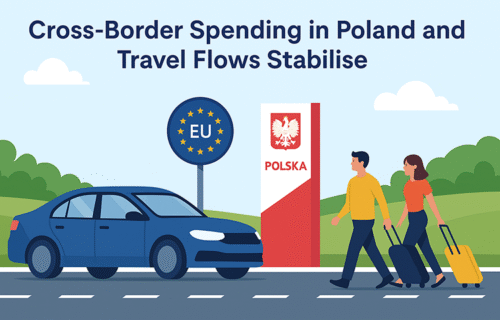Poland recorded nearly 286.4 million border crossings in 2024, underscoring its position as one of Central Europe’s busiest transit and shopping destinations. New data from Statistics Poland (GUS) show that 160.4 million crossings were made by foreigners entering Poland and 126 million by Polish residents travelling abroad .
Total cross-border expenditure climbed to PLN 77.7 billion, an 8.2 percent increase compared with 2023. Foreign visitors spent PLN 46.64 billion (+5.3%), while Poles spent PLN 31.05 billion (+12.9%) abroad . Average spending per trip reached PLN 585 for foreigners and PLN 494 for Poles .
Most journeys were short day-trips concentrated along Poland’s western and southern frontiers. Shopping remained the main motive: 57.6 percent of foreigners entered Poland primarily to purchase goods, followed by professional or business visits (12.7 percent) and leisure or family travel (8.9 percent). Among Polish travellers, 43.6 percent went abroad for holidays or recreation, 22.8 percent for shopping, and 15.7 percent for professional purposes .
Spending patterns differed on each side of the border. Non-residents visiting Poland devoted most of their budgets to non-food retail goods, whereas Poles abroad directed a larger share to services such as accommodation and dining. Travellers arriving by air and sea reported the highest average outlays per person, reflecting longer stays and higher incomes, while those crossing by land remained the majority in total volume.
Local border movement between Poland and Ukraine rebounded strongly. Under the small-border-traffic (LBT) scheme, 758.2 thousand crossings were made in 2024—an 18.3 percent increase over the previous year—with total spending of PLN 310.4 million (+16.6%) and an average of PLN 819 per person . LBT travellers represented 4.4 percent of all foreign crossings on the Polish-Ukrainian border and allocated roughly 85 percent of their expenditure to non-food goods .
Traffic volumes remained highest along Poland’s western and southern borders, particularly with Germany, Czechia, and Slovakia, while eastern crossings with Ukraine, Belarus, and Lithuania continued to grow following eased visa procedures for selected categories .
Economists note that the figures highlight a stabilising trend: while overall border movements have levelled off, total spending continues to rise, reflecting improved purchasing power, steady inflation, and resilient consumer demand. Analysts view the strong performance of retail-driven trips as both a strength and a vulnerability—sustaining local economies yet underscoring Poland’s reliance on short-term, consumption-based cross-border trade.
Source: GUS
